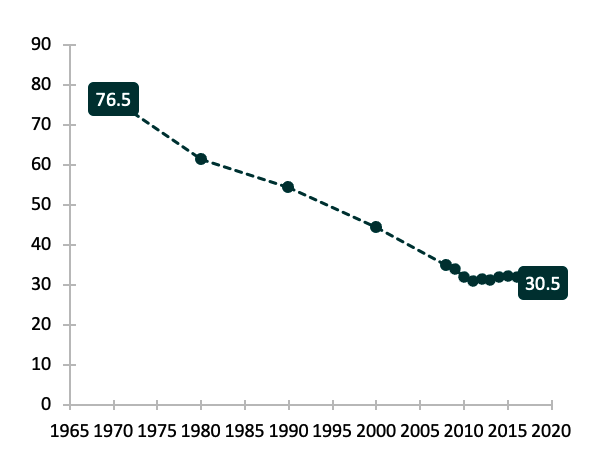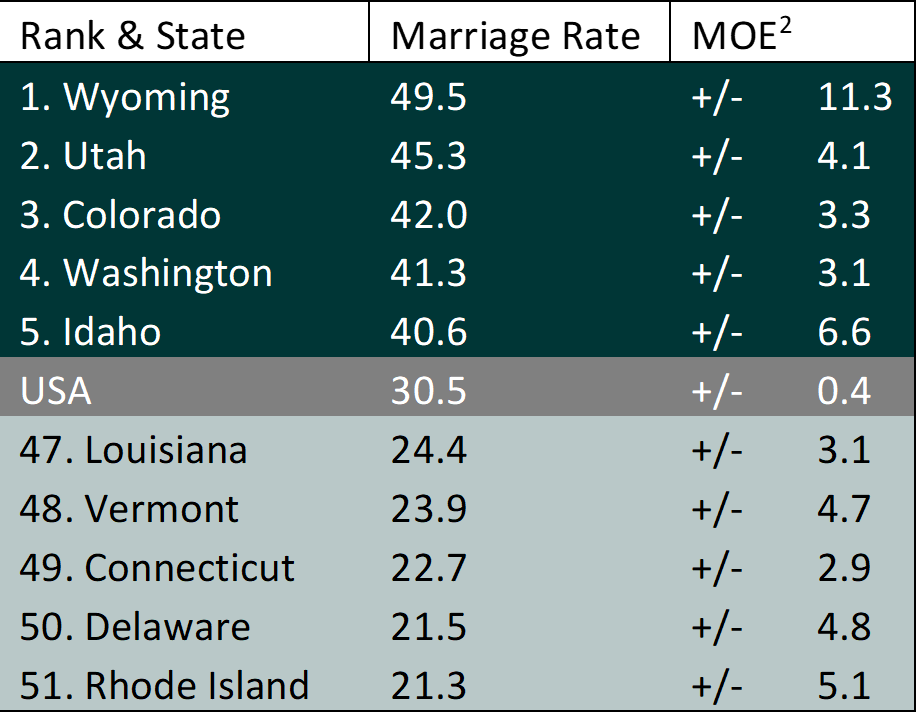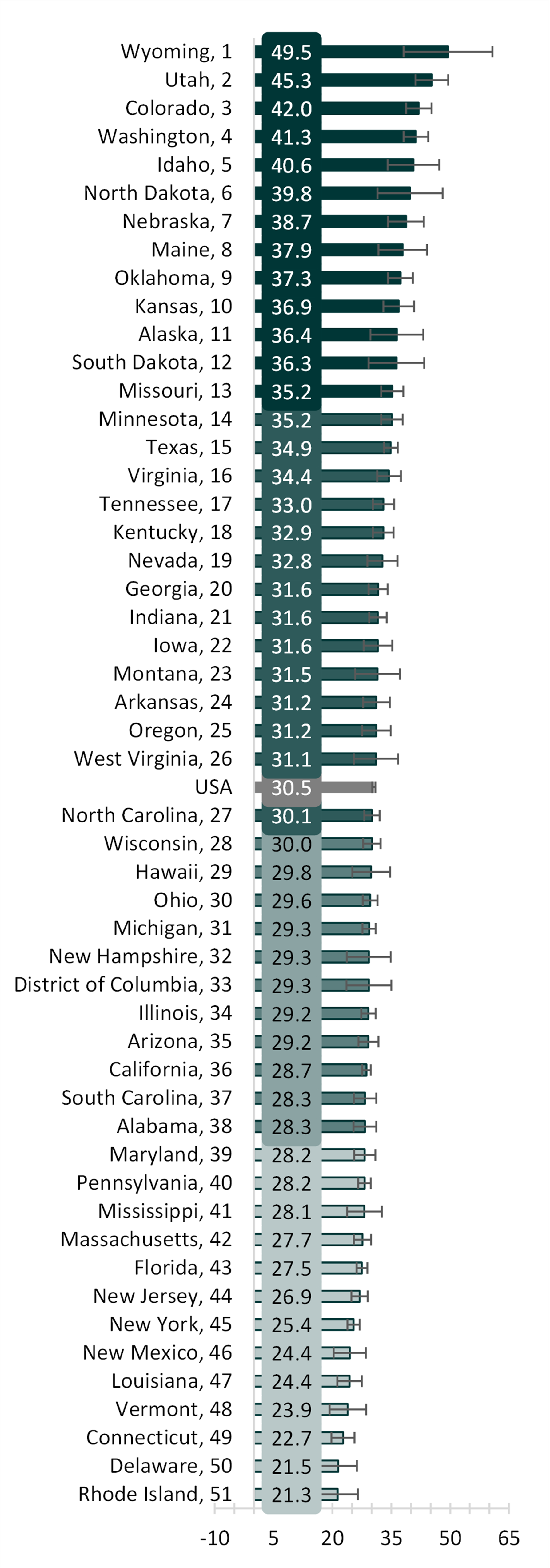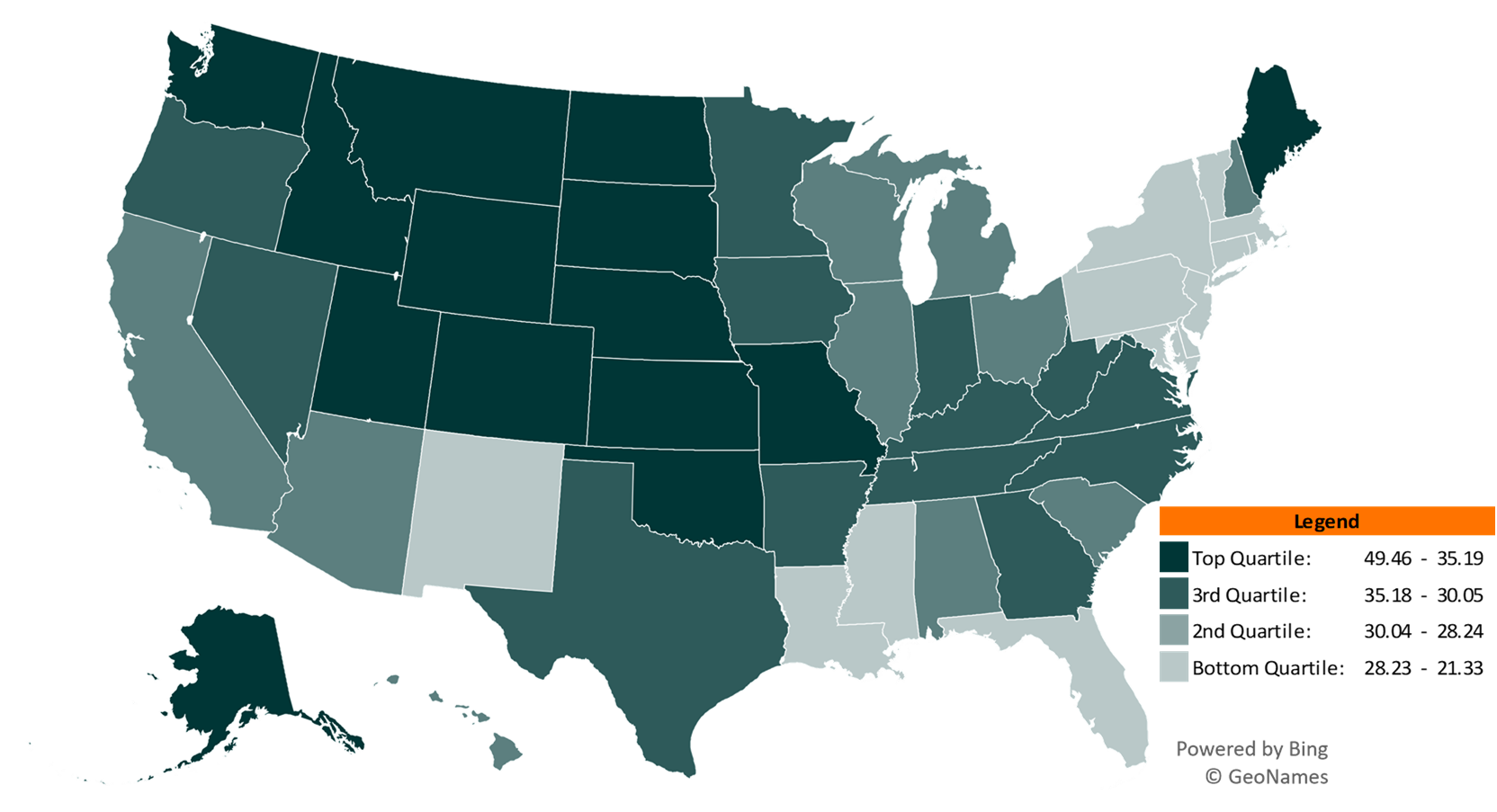Marriage Rate in the U.S.: Geographic Variation, 2019
This Family Profile is an update of FP-14-15, FP-15-20, FP-16-22, FP-17-25, FP-18-20, FP-19-22

Family Profile No. 24, 2020
Author: Leslie Reynolds
This Family Profile, an update of previous profiles on the marriage rate [FP-17-25; FP-18-20; FP-19-22], estimates adjusted marriage rates for the U.S. and each state for 2019. Using American Community Survey (ACS) data, we estimate the number of marriages occurring in the last year among unmarried women, calculate the margins of error, and describe geographic variation. For detailed information on the adjusted marriage rate from 2008-2017, see “Charting Marriage & Divorce in the U.S.: The Adjusted Marriage Rate” (Payne, 2018).
U.S. Marriage Rate, 20191
- The marriage rate continued to be stable in 2019, remaining at a 45-year low since 2010.
- In 2019, there were 30.5 marriages per 1,000 unmarried women.
- 2.2 million women married in 2019, an increase of about 117,742 marriages from 2010.
Figure 1. Women’s Adjusted Marriage Rate, 1970-2019

Five Highest and Lowest Marriage Rates, 2019
- Wyoming (surpassing Utah) now holds the top spot in terms of the marriage rate with 49 marriages per 1,000 unmarried women in 2019.
- Rhode Island continues to hold the lowest marriage rate in 2019. The rate decreased from 24 marriages per 1,000 unmarried women in 2018 (FP-19-22) to 21 marriages per 1,000 unmarried women in 2019.
Figure 2. Women's Highest and Lowest Marriage Rates

2MOE = Margin of Error. The MOE is a measure of sampling error and expresses the maximum range in which the rate is expected to differ from the actual proportion. The MOE is calculated for the derived estimates at the 90% confidence level.
State Rankings and Geographic Variation in Marriage Rates, 2019
- The states with the highest marriage rates (making up the 1st quartile) in 2019 had rates of at least 35.2 marriages per 1,000 unmarried women aged 15 and older. Among the states in the top quartile, all are substantially above the national average (30.5 marriages per 1,000 unmarried women).
- The states with the lowest marriage rates (making up the 4th quartile) in 2019 had fewer than 28.2 marriages per 1,000 unmarried women. Among the states in the bottom quartile, those with marriage rates considerably below the national average are Rhode Island, Delaware, Connecticut, Vermont, Louisiana, New Mexico, New Jersey, New York, Florida, Massachusetts, Mississippi, Pennsylvania, and Maryland.
Figure 3. State Variation in the Adjusted Marriage Rate per 1,000 Unmarried Women Aged 15+ by Quartile, 2019

Figure 4. Geographic Variation of Women’s Adjusted Marriage Rate Among States, 2019

- Most states in the Western region of the country had high marriages rates (1st or 2nd quartile).
- Exceptions include California, Arizona, and New Mexico.
- Midwestern states exhibited marriage rates in the top three quartiles with the largest share found in the first.
- Southern states are spread across each quartile. The largest share is found in the second.
- All states in the Northeast (except for Maine) exhibited low marriage rates (3rd or 4th quartile).
Data Sources
- Clarke. S. C. (1995). Advanced report of final marriage statistics, 1989 and 1990. Monthly Vital Statistics Report, 42(12). National Center for Health Statistics. https://www.cdc.gov/nchs/data/mvsr/supp/mv43_12s.pdf
- National Center for Health Statistics (1974). Summary report final marriage statistics, 1970. Monthly Vital Statistics Report, 23(2), Supp.1. U.S. Department of Health, Education, and Welfare. https://www.cdc.gov/nchs/data/mvsr/supp/mv23_02s1acc.pdf
- National Center for Health Statistics (1983). Advance report of final marriage statistics, 1980. Monthly Vital Statistics Report, 32(5), Supp. U.S. Department of Health and Human Services. https://www.cdc.gov/nchs/data/mvsr/supp/mv32_05s.pdf
- National Center for Health Statistics (2001). Births, marriages, divorces, and deaths: Provisional data for January-December, 2000. National Vital Statistics Report, 49(6), Associated Table 3. Department of Health & Human Services, Center for Disease Control and Prevention. https://www.cdc.gov/nchs/data/nvsr/nvsr49/nvsr49_06.pdf
- U.S. Census Bureau (2020). American Community Survey, 2019 1-Year Estimates [Table B12001]. Retrieved from: https://data.census.gov/cedsci/table?q=B12001&lastDisplayedRow=18&table=B12001&tid=ACSDT1Y2019.B12001
- U.S. Census Bureau (2020). American Community Survey, 2019 1-Year Estimates [Table B12501]. Retrieved from: https://data.census.gov/cedsci/table?q=B12501&lastDisplayedRow=10&table=B12501&tid=ACSDT1Y2019.B12501
References
- Allred, C. (2019). Marriage rate in the U.S.: Geographic variation, 2018. Family Profiles, FP-19-22. Bowling Green, OH: National Center for Family & Marriage Research. https://doi.org/10.25035/ncfmr/fp-19-22.
- Hemez, P. (2017). Marriage rate in the U.S.: Geographic variation, 2016. Family Profiles, FP-17-25. Bowling Green, OH: National Center for Family & Marriage Research. https://doi.org/10.25035/ncfmr/fp-17-25
- Payne, K. K. (2018). Charting marriage and divorce in the U.S.: The adjusted divorce rate. Bowling Green, OH: National Center for Family & Marriage Research. https://doi.org/10.25035/ncfmr/adr-2008-2017
Suggested Citation
- Reynolds, L. (2020). Marriage rate in the U.S.: Geographic variation, 2019. Family Profiles, FP-20-24. Bowling Green, OH: National Center for Family & Marriage Research. https://doi.org/10.25035/ncfmr/fp-20-24

This project is supported with assistance from Bowling Green State University. From 2007 to 2013, support was also provided by the U.S. Department of Health and Human Services, Office of the Assistant Secretary for Planning and Evaluation. The opinions and conclusions expressed herein are solely those of the author(s) and should not be construed as representing the opinions or policy of any agency of the state or federal government.
Updated: 04/13/2021 02:37PM

